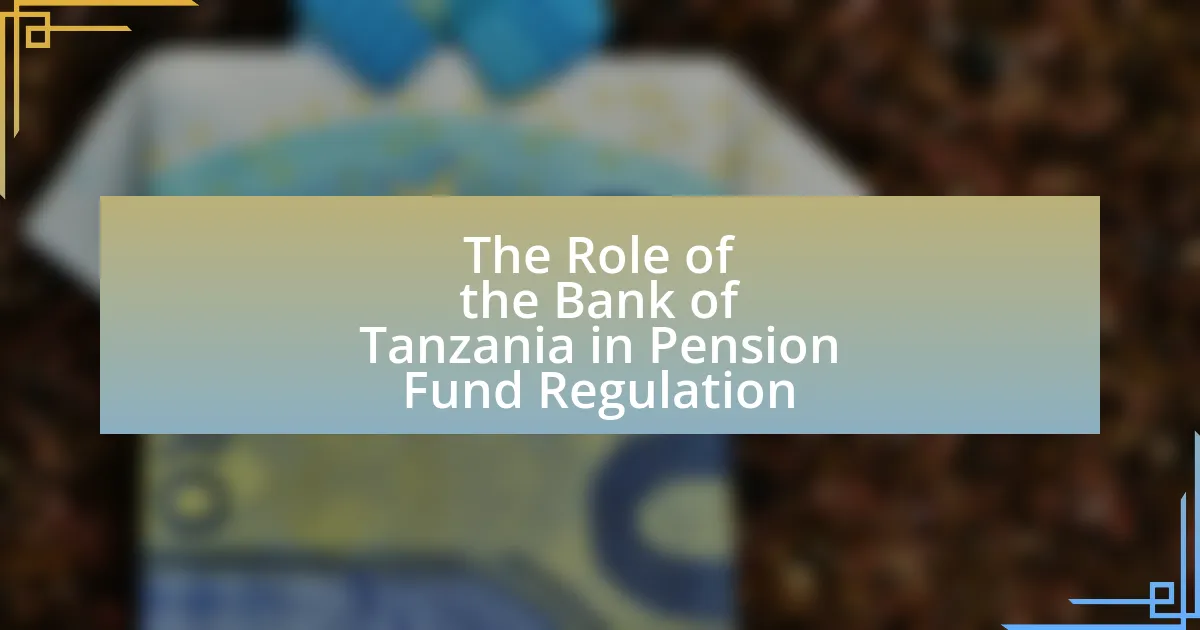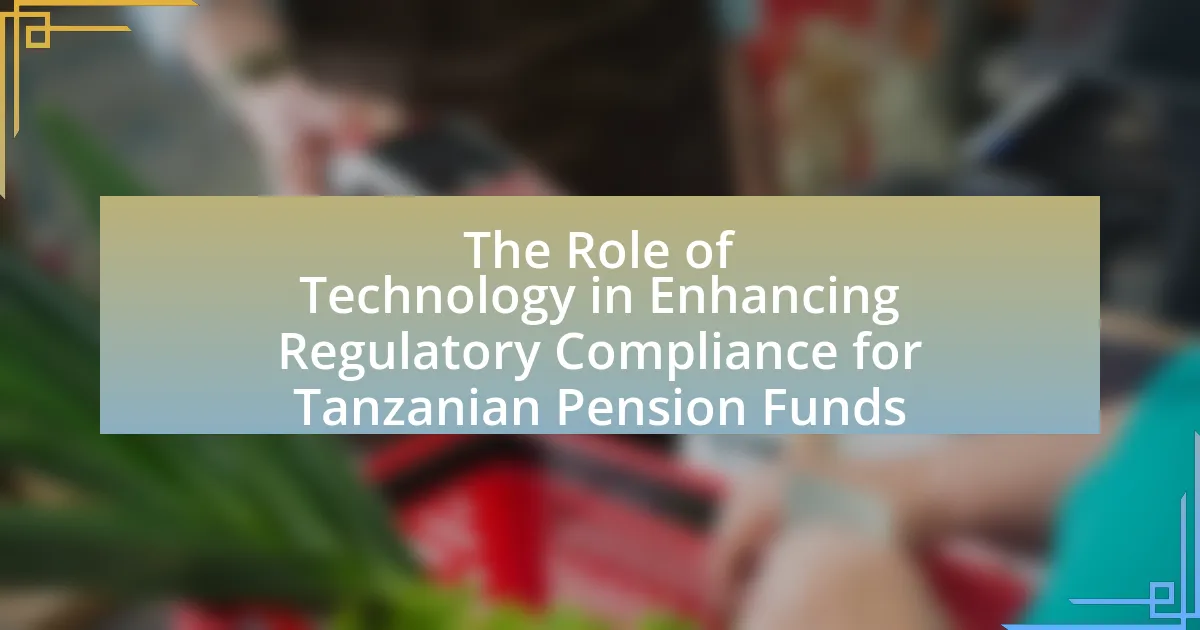The article critically examines the challenges facing pension fund regulators in Tanzania, highlighting issues such as inadequate regulatory frameworks, limited financial literacy, and insufficient data for effective oversight. It discusses how these challenges impact the sustainability of pension funds, the role of governance in regulation, and the economic factors that pose risks to fund stability. Additionally, the article explores the implications of these challenges for stakeholders, including beneficiaries and fund managers, and suggests potential solutions to enhance regulatory effectiveness and transparency in the pension sector.

What are the main challenges facing pension fund regulators in Tanzania?
The main challenges facing pension fund regulators in Tanzania include inadequate regulatory frameworks, limited financial literacy among stakeholders, and insufficient data for effective oversight. Inadequate regulatory frameworks hinder the ability to enforce compliance and protect beneficiaries, while limited financial literacy affects the understanding of pension products among both fund managers and members. Additionally, insufficient data restricts regulators’ capacity to monitor fund performance and assess risks accurately, leading to potential mismanagement of pension assets. These challenges are critical as they directly impact the sustainability and effectiveness of pension systems in Tanzania.
How do regulatory frameworks impact pension fund management?
Regulatory frameworks significantly impact pension fund management by establishing rules and guidelines that govern investment strategies, risk management, and reporting requirements. These frameworks ensure that pension funds operate within legal boundaries, promoting transparency and protecting beneficiaries’ interests. For instance, in Tanzania, the Pension Act mandates specific investment limits and asset diversification to mitigate risks, thereby influencing how pension funds allocate their resources. Compliance with these regulations is crucial, as failure to adhere can result in penalties or loss of license, which underscores the importance of regulatory frameworks in shaping the operational landscape of pension fund management.
What specific regulatory challenges are present in Tanzania?
Tanzania faces specific regulatory challenges including inadequate legal frameworks, lack of enforcement mechanisms, and limited capacity of regulatory bodies. The legal frameworks governing pension funds are often outdated, leading to inconsistencies in compliance and oversight. Additionally, the enforcement mechanisms are weak, resulting in non-compliance by pension fund managers. The capacity of regulatory bodies, such as the Pension Fund Regulatory Authority, is also limited due to insufficient resources and expertise, hindering effective regulation and supervision of the pension sector. These challenges contribute to inefficiencies and risks within the pension fund system in Tanzania.
How do these challenges affect the sustainability of pension funds?
The challenges facing pension fund regulators in Tanzania significantly undermine the sustainability of pension funds. These challenges include inadequate regulatory frameworks, poor governance, and limited investment opportunities, which lead to reduced fund performance and increased financial risks. For instance, a lack of robust regulatory oversight can result in mismanagement of assets, while limited investment options restrict the ability of funds to achieve optimal returns. Consequently, these factors contribute to lower payouts for retirees and threaten the long-term viability of pension systems, as evidenced by reports indicating that many pension funds in Tanzania are struggling to meet their obligations due to these systemic issues.
What role does governance play in pension fund regulation?
Governance plays a crucial role in pension fund regulation by ensuring accountability, transparency, and effective decision-making within pension funds. Effective governance structures help mitigate risks associated with mismanagement and fraud, which are significant concerns in pension fund operations. For instance, the International Organization of Pension Supervisors emphasizes that strong governance frameworks can enhance the integrity of pension systems, leading to better investment performance and protection of beneficiaries’ interests. In Tanzania, the implementation of governance standards is essential for addressing challenges such as inadequate oversight and lack of stakeholder engagement, which can undermine the sustainability of pension funds.
How does governance structure influence regulatory effectiveness?
Governance structure significantly influences regulatory effectiveness by establishing clear roles, responsibilities, and accountability mechanisms within regulatory bodies. A well-defined governance structure ensures that regulatory agencies operate efficiently, facilitating timely decision-making and effective enforcement of regulations. For instance, in Tanzania, the governance framework of pension fund regulators, which includes oversight committees and stakeholder engagement, directly impacts their ability to monitor compliance and address issues promptly. Research indicates that countries with robust governance structures experience higher regulatory compliance rates, as seen in the World Bank’s report on regulatory frameworks in developing economies, which highlights the correlation between governance quality and regulatory outcomes.
What are the common governance issues faced by pension funds in Tanzania?
Common governance issues faced by pension funds in Tanzania include lack of transparency, inadequate regulatory frameworks, and conflicts of interest among fund managers. Transparency is often compromised due to insufficient disclosure of financial information, which hinders stakeholders’ ability to make informed decisions. The regulatory frameworks are frequently outdated or poorly enforced, leading to gaps in oversight and accountability. Additionally, conflicts of interest arise when fund managers prioritize personal gains over beneficiaries’ interests, undermining the integrity of pension fund management. These issues have been highlighted in various reports, including the World Bank’s assessment of pension systems in Tanzania, which emphasizes the need for improved governance structures to protect members’ assets and ensure sustainable fund performance.
How does the economic environment affect pension fund regulation?
The economic environment significantly influences pension fund regulation by determining the financial stability and investment opportunities available to pension funds. Economic factors such as interest rates, inflation, and market performance directly affect the returns on investments made by pension funds, which in turn impacts their ability to meet future liabilities. For instance, low interest rates can lead to reduced income from fixed-income investments, prompting regulators to adjust guidelines to ensure funds remain solvent and can fulfill their obligations to beneficiaries. Additionally, economic downturns may lead to increased scrutiny and tighter regulations to protect pension assets, as seen during the 2008 financial crisis when many countries revised their pension regulations to enhance fund resilience against market volatility.
What economic factors pose risks to pension fund stability?
Economic factors that pose risks to pension fund stability include inflation, interest rate fluctuations, and economic downturns. Inflation erodes the purchasing power of pension payouts, making it difficult for funds to meet their obligations. Interest rate fluctuations impact the returns on fixed-income investments, which are a significant portion of pension fund portfolios; lower rates can lead to reduced income. Economic downturns can result in increased unemployment and lower contributions to pension funds, further straining their financial health. For instance, during the 2008 financial crisis, many pension funds experienced significant losses due to market volatility and declining asset values, highlighting the vulnerability of pension funds to economic conditions.
How do inflation and currency fluctuations impact pension funds?
Inflation and currency fluctuations significantly impact pension funds by eroding the purchasing power of the funds’ assets and affecting their investment returns. When inflation rises, the real value of pension payouts diminishes, leading to potential shortfalls in meeting beneficiaries’ needs. For instance, if inflation averages 3% annually, a fixed pension benefit loses approximately 30% of its purchasing power over a decade. Currency fluctuations can also affect pension funds, especially those investing in foreign assets; a depreciation of the local currency can reduce the value of these investments when converted back to the local currency, further straining the fund’s financial health. In Tanzania, where the local currency has experienced volatility, pension funds face increased risks that can jeopardize their long-term sustainability and ability to fulfill obligations to retirees.

What are the implications of these challenges for stakeholders?
The implications of challenges facing pension fund regulators in Tanzania for stakeholders include increased financial risk, regulatory uncertainty, and potential loss of trust in the pension system. Financial risk arises as inadequate regulation may lead to mismanagement of funds, affecting the returns for beneficiaries. Regulatory uncertainty can hinder investment decisions, as stakeholders may be unsure of compliance requirements, impacting the overall stability of the pension market. Furthermore, a lack of effective oversight can erode trust among contributors and retirees, leading to lower participation rates in pension schemes. These factors collectively threaten the sustainability of pension funds and the financial security of stakeholders involved.
How do challenges affect pension fund beneficiaries?
Challenges significantly impact pension fund beneficiaries by reducing their expected retirement income and financial security. For instance, issues such as inadequate funding, poor investment strategies, and regulatory inefficiencies can lead to lower returns on pension investments. According to the World Bank, many pension funds in developing countries, including Tanzania, face underfunding, which directly affects beneficiaries’ payouts. Additionally, market volatility can erode the value of pension assets, further jeopardizing the financial stability of beneficiaries. These challenges highlight the importance of effective regulation and management to ensure that pension funds can meet their obligations to beneficiaries.
What risks do beneficiaries face due to regulatory challenges?
Beneficiaries face significant risks due to regulatory challenges, including reduced access to benefits, financial instability, and potential loss of retirement savings. Regulatory inconsistencies can lead to delays in benefit disbursement, as seen in Tanzania where pension fund regulations often lack clarity and enforcement. This uncertainty can result in beneficiaries not receiving timely payments, which directly impacts their financial security. Furthermore, inadequate regulatory oversight may expose pension funds to mismanagement or fraud, jeopardizing the assets intended for beneficiaries. For instance, a report by the International Labour Organization highlights that poorly regulated pension systems can lead to a loss of up to 30% of pension assets, underscoring the critical need for robust regulatory frameworks to protect beneficiaries.
How can beneficiaries advocate for better regulation?
Beneficiaries can advocate for better regulation by organizing collective efforts to communicate their needs and concerns to policymakers. This can be achieved through forming advocacy groups that represent their interests, conducting research to highlight the impact of current regulations, and engaging in dialogue with regulatory bodies to propose specific changes. For instance, in Tanzania, beneficiaries can utilize platforms such as public forums or consultations to present data on how existing pension regulations affect their financial security, thereby influencing legislative reforms.
What impact do regulatory challenges have on fund managers?
Regulatory challenges significantly impact fund managers by increasing compliance costs and operational complexities. Fund managers must allocate substantial resources to ensure adherence to evolving regulations, which can divert attention from investment strategies and performance optimization. For instance, in Tanzania, the introduction of stricter reporting requirements and governance standards has necessitated additional staffing and technology investments, thereby straining budgets and potentially reducing returns for investors. Furthermore, regulatory uncertainties can lead to hesitancy in decision-making, as fund managers may delay investments or strategic shifts due to concerns about future compliance implications.
How do fund managers navigate regulatory complexities?
Fund managers navigate regulatory complexities by implementing robust compliance frameworks and engaging in continuous education about evolving regulations. These frameworks include systematic processes for monitoring regulatory changes, ensuring adherence to local laws, and maintaining transparent communication with regulatory bodies. For instance, in Tanzania, fund managers must comply with the Pension Funds Act, which mandates specific reporting and governance standards. By leveraging technology for compliance tracking and investing in legal expertise, fund managers can effectively manage the intricacies of regulatory requirements, thereby minimizing risks associated with non-compliance.
What strategies can fund managers employ to mitigate risks?
Fund managers can employ diversification, hedging, and active monitoring as strategies to mitigate risks. Diversification involves spreading investments across various asset classes to reduce exposure to any single investment’s volatility. For instance, a well-diversified portfolio can lower risk by including equities, bonds, and alternative investments, which historically have shown different performance patterns during market fluctuations. Hedging, on the other hand, utilizes financial instruments such as options and futures to offset potential losses in investments. This strategy can protect against adverse price movements, providing a safety net for fund performance. Active monitoring entails regularly reviewing and adjusting the investment portfolio based on market conditions and performance metrics, ensuring that risks are managed proactively. These strategies collectively enhance the resilience of pension funds against market uncertainties, which is crucial for maintaining the financial health of pension schemes in Tanzania.

What solutions can be implemented to address these challenges?
To address the challenges facing pension fund regulators in Tanzania, implementing a robust regulatory framework is essential. This framework should include clear guidelines for fund management, enhanced transparency requirements, and regular audits to ensure compliance. For instance, adopting international best practices, such as those outlined by the International Organization of Pension Supervisors, can improve governance and risk management in pension funds. Additionally, investing in capacity building for regulators through training programs can enhance their ability to oversee and enforce regulations effectively. Evidence from countries with successful pension systems, like Chile, shows that strong regulatory frameworks lead to increased investor confidence and better fund performance.
How can regulatory frameworks be improved in Tanzania?
Regulatory frameworks in Tanzania can be improved by enhancing transparency, increasing stakeholder engagement, and adopting technology-driven solutions. Transparency can be achieved by mandating regular reporting and audits for pension funds, which would foster accountability and trust among stakeholders. Increasing stakeholder engagement involves creating platforms for dialogue between regulators, pension fund managers, and beneficiaries, ensuring that diverse perspectives are considered in policy-making. Additionally, adopting technology-driven solutions, such as digital platforms for monitoring fund performance and compliance, can streamline processes and reduce inefficiencies. These improvements are supported by the need for a more robust regulatory environment, as highlighted in the “Challenges Facing Pension Fund Regulators in Tanzania: A Critical Review,” which emphasizes the importance of effective governance in enhancing the performance of pension funds.
What best practices from other countries can be adopted?
Countries like Chile and the Netherlands offer best practices that Tanzania can adopt to enhance its pension fund regulation. Chile’s individual account system, which allows workers to manage their retirement savings, has led to increased savings rates and better investment returns. The Netherlands employs a robust governance framework that emphasizes transparency and accountability, ensuring that pension funds operate efficiently and in the best interest of beneficiaries. These practices have resulted in higher pension fund performance and greater financial security for retirees, as evidenced by Chile’s pension system being one of the most successful in Latin America and the Netherlands consistently ranking high in global pension indices. Adopting similar frameworks could improve the effectiveness of Tanzania’s pension system.
How can stakeholder engagement enhance regulatory effectiveness?
Stakeholder engagement enhances regulatory effectiveness by fostering collaboration and improving compliance among involved parties. Engaging stakeholders, such as pension fund managers, beneficiaries, and government agencies, allows regulators to gather diverse perspectives, which can lead to more informed decision-making and tailored regulations. For instance, when stakeholders participate in the regulatory process, they are more likely to understand and adhere to the rules, as evidenced by studies showing that inclusive regulatory frameworks lead to higher compliance rates. Additionally, stakeholder feedback can identify potential issues early, allowing regulators to address concerns proactively, thus enhancing the overall effectiveness of the regulatory environment.
What role does technology play in improving pension fund regulation?
Technology enhances pension fund regulation by enabling real-time data analysis and improving transparency. Advanced software solutions allow regulators to monitor fund performance and compliance more effectively, reducing the risk of fraud and mismanagement. For instance, the implementation of blockchain technology can provide immutable records of transactions, ensuring accountability. Additionally, data analytics tools facilitate the identification of trends and risks within pension funds, allowing for proactive regulatory measures. These technological advancements contribute to a more robust regulatory framework, ultimately safeguarding the interests of pension fund members.
How can technology streamline compliance and reporting?
Technology can streamline compliance and reporting by automating data collection and analysis processes, thereby reducing manual errors and increasing efficiency. For instance, regulatory technology (RegTech) solutions enable pension fund regulators to monitor compliance in real-time, ensuring that funds adhere to legal requirements without extensive manual oversight. According to a report by Deloitte, the adoption of RegTech can lead to a 30% reduction in compliance costs and a significant decrease in the time required for reporting, allowing regulators to focus on strategic oversight rather than administrative tasks.
What innovations are emerging in pension fund management?
Innovations emerging in pension fund management include the integration of artificial intelligence and machine learning for data analysis, enhanced risk management, and personalized investment strategies. These technologies enable pension funds to analyze vast amounts of data quickly, improving decision-making processes and optimizing asset allocation. For instance, AI-driven algorithms can predict market trends and adjust portfolios in real-time, leading to potentially higher returns. Additionally, blockchain technology is being explored for its ability to enhance transparency and security in transactions, which is crucial for building trust among stakeholders. These innovations are reshaping the landscape of pension fund management by increasing efficiency and responsiveness to market changes.
What are the best practices for pension fund regulators in Tanzania?
The best practices for pension fund regulators in Tanzania include establishing clear regulatory frameworks, enhancing transparency, and promoting effective governance. Clear regulatory frameworks ensure that pension funds operate within defined legal parameters, which helps protect beneficiaries’ interests. Enhancing transparency involves regular reporting and disclosure of fund performance, enabling stakeholders to make informed decisions. Promoting effective governance includes implementing strong oversight mechanisms and ensuring that fund managers adhere to ethical standards. These practices are supported by the need for accountability and the safeguarding of pension assets, which are critical for the financial security of retirees in Tanzania.
How can regulators ensure transparency and accountability?
Regulators can ensure transparency and accountability by implementing robust reporting requirements and regular audits for pension funds. These measures compel pension funds to disclose financial information and operational practices, allowing stakeholders to assess performance and compliance. For instance, the International Organization of Pension Supervisors emphasizes that regular audits can reveal discrepancies and enhance trust among beneficiaries. Additionally, establishing clear guidelines for communication with stakeholders fosters an environment of openness, which is crucial for accountability.
What ongoing training and development opportunities are essential for regulators?
Ongoing training and development opportunities essential for regulators include specialized workshops, continuous professional education, and exposure to international regulatory practices. These opportunities ensure that regulators remain updated on evolving financial regulations, risk management techniques, and compliance standards. For instance, participation in workshops led by organizations such as the International Organization of Pension Supervisors can enhance knowledge and skills relevant to pension fund oversight. Additionally, continuous professional education programs, often mandated by regulatory bodies, help maintain the competency of regulators in a rapidly changing financial landscape.





